A Dozen articles on Asian Arts
byIntroduction
Here, I present a dozen short essays on Asian Arts, History and Culture. They show facts, opinions, as well as my own theories. I hope you will find this information of interest.1. The oldest molded gourd.
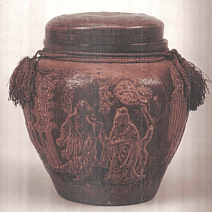
In the autumn of 1996, an exhibition entitled "Imperial treasures from Ho-ryu-ji" was held at the Tokyo National Museum. Among the treasures was exhibited a gourd jar, decorated with 9 figures (and Chinese characters) by molding(H. 16.5cm). The lid is a decorated gourd(floral patterns), too. This jar was made of gourd which grew in a mold (hardwood or ceramic).
This presumably was made in China, because the Japanese have little history of decorated gourds. Also, the style of the decoration is Chinese.
There are two types of mold to cast gourd. The first type of mold is
wooden negative. It is curved directly by the artist and used only once
in one season.  The second type of mold is a wooden positive model. It consists
of several parts. The craftsmen cover it with clay and then remove it partly.
They dry/fire the clay to make a clay mold. Thanks to this method, many
clay molds could be made from a single model and thus enabled commercial
production of decorated gourd. Hobei province was the center of this technique.
Casting a gourd is not easy. Shipping gourd items were said to be
1 per cent among products from a farm. Another experiment informed
about 2000 decorated gourd were produced in one mu farm (1/6 acre).
This may depend on quality control and pest control.
products from a farm.
The second type of mold is a wooden positive model. It consists
of several parts. The craftsmen cover it with clay and then remove it partly.
They dry/fire the clay to make a clay mold. Thanks to this method, many
clay molds could be made from a single model and thus enabled commercial
production of decorated gourd. Hobei province was the center of this technique.
Casting a gourd is not easy. Shipping gourd items were said to be
1 per cent among products from a farm. Another experiment informed
about 2000 decorated gourd were produced in one mu farm (1/6 acre).
This may depend on quality control and pest control.
products from a farm.
During the Ching dynasty, decorated gourds were often used for cricket cages. (The Chinese rise crickets to fight in betting competitions.)
Although this "casting gourd" technique was developed in China, real specimens have only survived from the 17th Century in China, in Taiwan, as well as in the other countries. The museum regards this exceptional jar as being from the Tang-dynasty (7-8th Century), because of its style. Some gourds (perhaps molded) made before the Han dynasty were excavated, but they were not decorated.
Among the treasures is the gourd jar which was transferred from Ho-ryu-ji monastery to the Imperial Household in 1878. Emperor Meiji gave 10,000 yens to Ho-ryu-ji in return.
In 1997, I found one bulletin (ref.2) where I learnt that the gourd jar was documented in the book compiled in A.D. 1238 by a monk in Ho-ryu-ji. I've concluded that THIS is the oldest gourd jar decorated by molding. It becomes certain that it dates from between 1238 and late 7th Century. I hope the museum will make a Carbon14 dating test on the jar.
I add a rare example of a Japanese molded gourd incense holder, perhaps
20th Century, coated with a light layer of lacquer.

This was made for SENCHA tea ceremony.
- ref. Hugh Moss and Tsam, Chinese Decorated Gourd, 1983, HongKong.
- ref. T. Kiuchi, Hassin Gourd Jar, MUSEUM, No.97, 1959/4, Tokyo
2. Mold and the Silk road
Mould disaster might support glory of the central Asian silk road.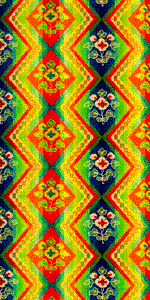 This silk is a replica
of an 8th Century Tang style cloth.
This silk is a replica
of an 8th Century Tang style cloth.
I think sea transportation would be more profitable than camel caravan transportations, even in A.D. 5th Century. A single ship is able to carry a large amount of parcels and can reduce stopping site: it means the number of customs. Indeed marine wreckage was popular, but desert wreckage as well as desert bandits were, too. Indeed, muslim customs and merchants got a lot on commissions, an economical principle ruled the rate. If the silk price by sea was higher than the one by desert in the consumer markets (Byzantium, Cairo, Baghdad, Paris, etc), it should force the commission low.
Why did the desert route survive after the indirect sea route began to transfer parcels to the West?
I think one of the reasons should be the deterioration of cloth by mould
and worms under tropical and humid environments. In ref.1, Doctor of Science:
Torao Ohtsuki talked "When exporting silk thread to Europe, we struggled
mould disaster. Now, we carefully prevent it. To shut off from humidity,
we seal silk threads in metal boxes and ship. Without sealing, mould eat
silk in the Indian Ocean. ". I think this should be the reason to support
the desert route. In desert, mould can't grow. In Astana and Tunghuan,
many beautiful silk fragments were unearthed with incredible condition.
I show a pair of silk brocade shoes unearthed in Astana.

In Tang dynasty, documents recorded stopping in tropical ports to wait season wind for some months. It should be often that mould disaster happened to silk at that time.
Recently, French wines are transferred in REFER CONTAINER to Japan. In Tang dynasty, desert root is natural REFER route for silk. It was the best route to transfer high quality silk. Another factor is the price of silk. Even now, luxury silk is more expensive than gold by weight. It fits caravan transports, which can't transfer massive containers like ceramics.
- " Artifacts and Mould" ,News of National Museums, No.28, 1949/9/1, Tokyo
- Singchang Uigur Museum, Silkroad, Han,Tang textiles, 1972, Beijing
3. Harpy in Tang Empire
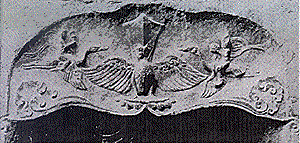
I was surprised that in early 8th century, at the court of Tang Empire, a very occidental monster: harpy might be popular. At least this example of Harpy with two faces in A.D. 701-750 in China, I can appreciate. I kindly request iconographic assistance concerning this image from Western scholars.
 This
is a ceil ornament of nitch limestone which contains a Buddha and
two bodhisatovas. Entire panel size is about 100cm high.
The main part seems rather banal, but the ceil seems extravagant. Left
face was destroyed, but many scholars guess it had two faces. It is irregular
that two immortals with cranes donate something. Usually buddhist canonical
aprasas donate. But some examples are in Japanese ancient buddhist collections.
Left part of this stone panel was damaged and repaired with stucco. Fortunately,
the harpy and the right immortal with crane are original. Left part of
left crane and left crowd look like being restored.
This
is a ceil ornament of nitch limestone which contains a Buddha and
two bodhisatovas. Entire panel size is about 100cm high.
The main part seems rather banal, but the ceil seems extravagant. Left
face was destroyed, but many scholars guess it had two faces. It is irregular
that two immortals with cranes donate something. Usually buddhist canonical
aprasas donate. But some examples are in Japanese ancient buddhist collections.
Left part of this stone panel was damaged and repaired with stucco. Fortunately,
the harpy and the right immortal with crane are original. Left part of
left crane and left crowd look like being restored.
I am finding the root of the cap like ENAN( later middle age cap of a lady ,in France, Flandre, etc) of the harpy. The style looks Western.
This panel is one of 29 panels from Baoquin temple in Xsian, Shensi province. 19 panels are in Tokyo National Museum, 2 in Freer Gallery, 1 in Boston Museum. Engraved scriptions show these panels were supervised and donated by eunuchs in Tang Empire Court around A.D. 701-750. Others don't show such irregular ornament. They have ordinary ornaments: aprasas, saint trees, or decorated canopies.
During Tang dynasty, many religions have temples in the capitol including Nestorian Christians. I feel one of them brought this harpy iconography?
Ref. Toshio Fukuyama, Grouping of the Buddhist Reliefs of the Pao-Ching-Ssu
Temple in Hsi-an, China, ARS BUDDHICA, VOL 9, Oct, 1950, Osaka
4. Viking with a Buddha
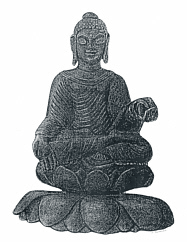
In July, 1954, a small bronze buddha was unearthed in Helgö in Ekerö Island in Lake Mälaren in Sweden, when archeologists were searching and digging a Viking ruin. Now, in National Historical Museum, Stockholm. Prof. Namio Egami: a famous japanese archeologist about ancient nomad gazed it a few days after its descovery.
I quote a long scription from the original report. "The face is finely drawn with elbows and mouth inlaid with dark substance: eyes inlaid with turquoise(?) and on the right eye an irregular red colour; caste-mark of gold in the middle of the forehead; the ears have much drawn down lobes; the hair is ring punched and at the very top a small semi-globular calotte is placed; the neck has two parallel furrows (fat calluses)... The back has been more summarily modeled. An extra plate with holes at the neck. an indication of a tap between the shoulders and a riveting hole at the foot of the back of the lotus throne indicate that the figure has leant against a decorated backpiece. At both elbows there are extra applied square bronze plates (repairs?). At the discovery, there was round the neck and round the wrist a leather-strap 0.06 cm W. with folded and bent borders. Measures H. 8.4, greatest W. (the Throne) 6.4.Site M 34;-12"
Ref. W.Holmqvist ed., Excavations at Helgö, I, report for 1954-56, Stockholm
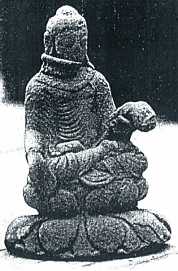 The
condition unearthed.
The
condition unearthed.
The leather strap shows that the owner (a Viking) regarded this bronze a talisman/amulet. The repairs are unskilled. Maybe done by foreign craftsmen (Russian?). On the style this buddha may be made in Swat or Kasimir: both are neighbours, but Swat is in Pakistan and Kasimir in India. Scholars think its date A.D. 8-9th century. The route to scandinavia is said "Amber route" , which transport amber from north and silk and others to north through Russian rivers and stepps. I guess river transportation should have been important.
I imagine over 5,000 km voyage of a Viking with a buddha with some fancy.
5. Jade and Dead preserved
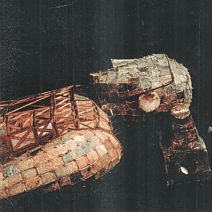
In ancient China, people believed that jade should preserve dead body unrotten in coffin. This funeral jade garment was made for the belief during B.C 1st century.
What made this superstition ?
I think dead with many jades should be often well preserved. People should think jade preserve such body, I think.
They are all lords or kings. Their tombs were carefully built and sealed from air. For a long funeral ceremony, some antiseptic procedure must be undertaken to the body. We know two examples of fresh body who died about B.C 150 or 300 in Hunan province (unearthed in 1972) and Hupei province (unearthed in 1975). At that time, for tens years, many lord bodies may be preserved fresh in their coffin. Graveyard robbers saw such bodies. Many stories show robbers discovered fresh body in the coffin. Destructers of the royal tombs also saw them, when a dynasty had fallen.
When was the superstition established?
In B.C. 20th-25th century, in Liangshou Culture of Southern China, a
lot of jades were packed in high-class coffin. I show a small example of
neolithic jade unearthed, about 4cm wide. 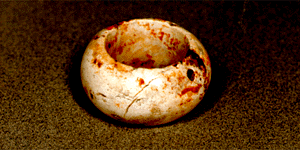 Since too many heavy jades were packed, I mind the body should have been
crashed. Jade mask from about 7th century was discovered in San-men-sha,
Shansi province. Consequently, between B.C.25th century and B.C.7th century,
this superstition must be established, I think.
Since too many heavy jades were packed, I mind the body should have been
crashed. Jade mask from about 7th century was discovered in San-men-sha,
Shansi province. Consequently, between B.C.25th century and B.C.7th century,
this superstition must be established, I think.
6. Painting without sky
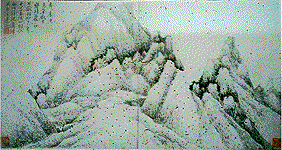
Most Chinese paintings after the 13th century don't have any sky. The sky is often blank.
One see much cloud, but cloud is under the summit of mountains, and it isn't on the sky. It move in valleys. I show an album leaf by Kung-Shien(ca. 1619-1689), from an old colotype reproduction, 22.1x44.7cm. It is now in Nelson and Atkins Gallery, Kansas-city, USA.
In 17th century Holland, Johannes Vermeer painted a beautiful sky in
his masterpiece: Landscape of DELFT ( Haag).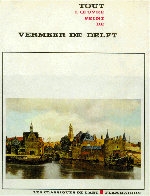 In early 16th century van Eyks? painted some too modern sky in a page of
"Hours of Turin" (1904 burned). Jan van Eyk's "Madonna and Christ with
chancellor Rollin" (Louvre) has a beautiful sky with cloud. I think northern
Europeans should discover beauty of sky.
In early 16th century van Eyks? painted some too modern sky in a page of
"Hours of Turin" (1904 burned). Jan van Eyk's "Madonna and Christ with
chancellor Rollin" (Louvre) has a beautiful sky with cloud. I think northern
Europeans should discover beauty of sky.
 Exceptional examples are
taoists or Buddhists paintings. Some draw cloud with deities. This example
is an album leaf in Beijing Palace Museum, maybe southen Sung, 26cm wide.
I guess the relation of religional themes and cloud. After the 13th century,
literati class ruled landscape painting's style.
Then Chinese painting parted from religion.
It is a reason that Chinese paintings seldom draw sky representation.
In "Landscape on the lute" (8th century in Sho-so -IN collection, Japan),
I saw some clouds on the sky. Thus I feel Chinese landscape paintings might
have sky in Tang dynasty. "Fu-shun mountains Handscroll": "Monumental work"
by Huang Kung-Wang(1269-1354) doesn't show any sky throughout this long
handscroll (National Palace Museum, Taipei).
Exceptional examples are
taoists or Buddhists paintings. Some draw cloud with deities. This example
is an album leaf in Beijing Palace Museum, maybe southen Sung, 26cm wide.
I guess the relation of religional themes and cloud. After the 13th century,
literati class ruled landscape painting's style.
Then Chinese painting parted from religion.
It is a reason that Chinese paintings seldom draw sky representation.
In "Landscape on the lute" (8th century in Sho-so -IN collection, Japan),
I saw some clouds on the sky. Thus I feel Chinese landscape paintings might
have sky in Tang dynasty. "Fu-shun mountains Handscroll": "Monumental work"
by Huang Kung-Wang(1269-1354) doesn't show any sky throughout this long
handscroll (National Palace Museum, Taipei).
- Kenneth Clark, Landscape into Art, 1966(1st ed. 1949),Pelican Books, England
- Laurence Sickman and W-K. Ho,
Eight Dynasties of Chinese painting, 1980
Plate sources
- Hakubundo, "Kyo Han-Sen San-sui", 1919, Osaka, Japan.
- Beijing Palace Museum, Anthology of Sung Album Paintings, 1970s?
7. Silk Export in B.C. 5th century.
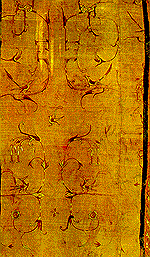

Both embroidries unearthed show silk trade through step route silkroad in B.C. 5th century, and production in southen china for export.
In 1949, S.I.Redenko excavated frozen kurugan No.5 in Pazyryk, Altai-Mountains, upper-Obi river. It is on a hill 1800m high above sea level. Pazyryk excavation was carried out in 1929 by M.P. Glaznov and S.I.Redenko,and between 1947 and 1949 by Redenko.
He found many well preserved leather, rag, cloth, and horse from the outer part of the loooted large tomb. Ironically, ancient looting introduced the tomb water and froze it. This is microclimate and lense shape frozen area were produced. Especially this saddle cover is excellent. An editor of the catalog (ref.1) regard it the oldest chinese silk:B.C.4-5th century. Approx. 60cm widith. About 50 threads per cm. Left fig.
 In 1982, chinese archeologists
excavated a small tomb of a lady in Chu kingdom (about late 5th century),
Mashan, Hubei Province, southern china. They found it a miracle box. This
preserved a lot of cloth with incredible condition in semi tropical environment.
I show a reconstructed pattern( upper right fig.) and a real detail of
the embroidry which is part of a gaun.
Famous ancient silks from Mawandou tomb No.1 in Changsha,
Hunan Province(about B.C.170) don't contain such pattern. This might
be a trend in the former age. This silk has 80-120 threads per cm, which
is high quality.
In 1982, chinese archeologists
excavated a small tomb of a lady in Chu kingdom (about late 5th century),
Mashan, Hubei Province, southern china. They found it a miracle box. This
preserved a lot of cloth with incredible condition in semi tropical environment.
I show a reconstructed pattern( upper right fig.) and a real detail of
the embroidry which is part of a gaun.
Famous ancient silks from Mawandou tomb No.1 in Changsha,
Hunan Province(about B.C.170) don't contain such pattern. This might
be a trend in the former age. This silk has 80-120 threads per cm, which
is high quality.
Comparing both cloths, I think a same design concept should make them; square components, bird and tree arrangement, and characreter of curves. In 1975, the editor can't see Mashan cloths. We are able to compare real cloths.
Two cloths are different on its technic. Pazyryk cloth is rough and free. Mashan cloth is fine and rigorous. Threads/cm is distinct. I think Pazyryk cloth should be an export silk at that time. From 13th century, chinese ceramic firms producted exportwares for foreign market. These exportwares are different from ceramics for domestic demand. Some are rough, some have pattern for foreigners, some are very large for muslim banquet, and some are mostly western on shape and pattern. Similar production for export should do in Chu kingdom in B.C.4-5th century. In that time, it should be difficult to trade directly between Chu kingdom (on Yantze river) and nothern nomads. Several kingdoms separated them. International marchants perhaps did such trade.
I've concluded Chu kingdom produced silk for foreigners in B.C. 4-5th century. It was different from domestic use on quality.
- MET and L.A.County Museum , From the Land of the Scythians, 1975, New York
- JingZhou Museum, Hubei Province, Chu Tomb No.1 at Mashan in Jiangling, 1985,Beijing
- Redenko "Pazyryk Treasures" in "Central Asia Tresures" assembled and translated by Kyuzo Kato, 1969, Tokyo
- Mawandou tomb No.1 in Changsha, 1973, Beijing
8. The origin of Sesshu Calligraphy
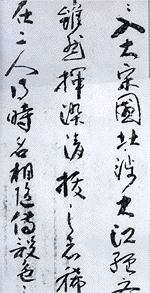

I think Sesshu To-yo(1420-1506, Japan) learned a calligraphy by Yen chen-ching(A.D.708-785).
Sesshu is a famous painter in 15th century Japan. Left is detail of
his inscription at upper part of his ink painting (entire size 149 x33cm
including painting, painter's inscription, and contemporaries inscriptions),
in Tokyo National Musem. It contains "By Sesshu, 1495 at seventy-six".
All scholars regard it autograph. He gave it to his disciple. He wrote his
history and thought about paintongs. This is a certificate for the disciple.

The entire work without additional colophons, I show.
Upper right figure is a rubbing of a calligraphy by Yen chen-ching(A.D.708-785), calligrapher and statesman in china. This is a letter draft to a minister to keep hierarchy in Tang Empire government written in November, A.D 764. This so called "cheng-tso-wei-tieh" has been popular as a classical calligraphy from 11th century. The original was lost, but was engraved on stone many times from 11th century. Many rubbings were supplied for students and scholars at that time.
Both running script styles are apparently alike.
Sesshu is not only a painter but also a monk of Zen buddhism. Leading cultural centers were Zen buddhism temples at that time Japan. He traveled to china as a member of official trade mission and a monk painter in 1468-1469.
I guess he got one rubbing of "cheng-tso-wei-tieh" in china. In that time china, the rubbings was popular. "Ko-ku-yao-lun" is a manual for the literati class to appreciate antiquities and utencils for scholars. It was revised in 1459. The revised edition lists the calligraphy as a fine one and two sorts of rubbings.
Another possibility, I'm guessing, is that he learned after a monk who had mastered "cheng-tso-wei-tieh" style. Among Zen monks, this style was sometimes learned, however, this inscription is much faithfull to Yen chen-ching style at that time Japan. I'd like to think Sesshu should learn directly the rubbing.
I here conclude that a calligraphy by Sesshu should be a good example for acceptance of Yen chen-ching style in late 15th century, Japan.
- plate source: Hoshokai ed., Sho-EN, vol.6,No.5, 1914, Tokyo
- Tokyo National Musem, Sesshu, 1956
- Ko-ku-yao-lun, first 1388, revised 1459, reprint in early 20th century, Shanghai
9. Chinese funeral black pottery figures
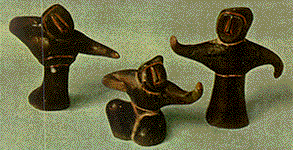
Warring period funeral black pottery figures had been regarded fakes, but new archeological descoveries might recover their honour?
In Beijin antique market, 1941, shops started to manage black pottery figurines. Next, similar pottery replicas of mirror and laquer dish, too. Freer Gallery, Honolulu Academy of Arts, Yamato Bunkakan, and Idemitu Museum collected them.
I show 3 figures in a plate. Highest is 8.6cm(ref.1). I feel them cute.
When firing, much smoke from deoxidized fire makes the surface black. Then potters polish the surface. These fugurines are funeral objects in tombs. They are said unearthed in Hui-chien, Honan province. Many scholars thought them pre-Han, perhaps B.C. 4th century.
An opinion spread; most or all figurines must be fakes. A rumour said one knows who made them. Report of an excavation in Hui-chien shows no black pottery, After WWII, many excavations of warring states period sites lacked such black figurinres . These facts support the doubt. They are rumours. Unfortunately, I can't know the definite opinion, however most think "All are fakes. there is no black funeral pottery in warring state period".
In 1965, Fujio Koyama( japanese scholar and potter) visited Beijing Palace Museum, and looked at some black funeral potteries unearthed in Hui-chien. It becomes sure that there are black funeral potteries with archeological Hui-chien excavations. Recently black funeral pottery figurines are unearthed from an archeological excavation of warring state period tomb in Shangtong province. This is a sort of recovery.
I think there should be many fakes,too. I hope thermoluminescence test on the potteries.
- San Sai No. 56, 1951,Dec., Tokyo
-
Sueji Umehara, On the Pottery Figures made as Ming-chi in the Warring States
Period
"YAMATO BUNKA", No.29, April,1959 - F. Koyama, Tavels with ceramics, 1971, Tokyo
10. Western taste destroyed chinese buddhist caves?
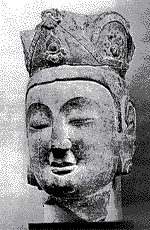
Between 1900 and 1949, many chinese buddhist scultupures in cave temples were destroyed, sacked, looted for the world antique market. I think western taste for classical sculptures influenced this destruction.
In many museums, we find such stone buddha/bodhisattova head as a chinese sculpture. 25 inches high, greyish stone, said from to Shangtong Province. Sui dynasty(A.D.6th century)?. Time desroyed some caves and made such heads , Persecutions(A.D.845) did, and several are unearthed as broken heads and bodies, but robbers did many between A.D. 1900 and A.D.1949.
Even a great marchant and a sort of accomplice: C.T. Loo wrote in PREFACE of ref.1,
"In Making This Catalogue I feel that it is more of a final inventory as I think the collecting of Chinese sculptures is nearly at its end. We must acknowledge, unfortunately, many accesible monuments have been damaged and fragments taken out to China ... cut... Four hundred years of devotion and inspiration, while only some forty years of unfortunate circumstances has consumated the removal and partial destruction of smome of the famous Buddhist sancturies. I feel so ashamed to have been one of the sources by which these National treasures has been dispered, Our only excuse is that none have ever been taken by us but all brought in the open market in competition with other buyers.."
I doubt that until late 19th century, far eastern collectors appreciated such stone heads?. Many classical volumes about antiquities in china contains no stone heads and fragments. Since they praized engraved scriptions(especially its date) on steles and stones, many buddhist fragments which has date inscrption were recorded in their collection catalogue. Traditional chinese collectors, howerever, didn't appreciate stone head without inscription. Traditional japanese collector's stance is ambiguious, but they did't like fragments. Some collectors didn't collect buddhist images, since they are objects for brief for them. In middle ages, a beutiful bronze head(early 8th century) was hidden under a pavillon in Ko-fu-Ku-JI: Nara Big Temple. There was no sense to appreciate it.
In Europe, from italian renessance, many have appreciated greco-roman stone fragments. Bust style sculptures are, too. In far east, sculpturers never made any bust before 19th century.
I think such european taste wanted chinese stone and influenced japanese collectors in early 20th century as modern trend.
- pl.source and ref. C.T.Loo, An Exhibition of Chinese Stone Sculptures, 1940, New York
11. Painting on folded paper
 "Autumn in Yellow Mountains"
A chinese landscape painting handscroll by Fa-jo-chen(1613-1696): ink on
paper, 25.5x 269.5cm, with painter's colophon dated 1690. Mr. Kikujiro
Takashima donated this to Tokoyo National Museum in 1965 with many masterpieces
of chinese calligraphy and paintings.
"Autumn in Yellow Mountains"
A chinese landscape painting handscroll by Fa-jo-chen(1613-1696): ink on
paper, 25.5x 269.5cm, with painter's colophon dated 1690. Mr. Kikujiro
Takashima donated this to Tokoyo National Museum in 1965 with many masterpieces
of chinese calligraphy and paintings.
In a showcase in the Museum, I found many strange vertical ink lines on it. When first looking, I think them connecting lines of papers, but they are too many. Gazing it in the showcase, I found they must not be connection lines.
Why are these lines?
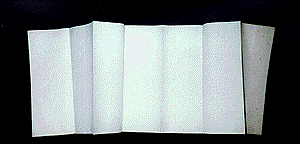 I
show an example of letterpads/document paper in late 19th-early 20th century.
If a painter draw on such papers, the brush touchs the folding lines and
produces such lines. This handscroll paper is folded by 11cm.
I
show an example of letterpads/document paper in late 19th-early 20th century.
If a painter draw on such papers, the brush touchs the folding lines and
produces such lines. This handscroll paper is folded by 11cm.
I wonder why the painter use such paper. Although this is a fine painting, I've checked the authenticity. It has no signatures on itself. However there are many such cases among the authentic masterpieces. For fan paintings, such lines are common, because it is often to draw on folding fan. It is not common for handscroll. I guess the paper was very fine or the painter should do a trial.
- Tokoyo National Museum, Chinese Painting and Calligraphy; The Gift of Mr. Takashima Kikujiro,
- Oswald Siren Chinese Painting vol.7 page 327, 1958
12. The oldest chinese stencil

A stencil in Sho-so in Collection, Nara, may be the oldest chinese stencil.
I often see chinese stencil papers as souvenirs; Panda,landscapes, figures, birds,etc. What is its use? What is its history?
In NIFTY-SERVE forum, Ms. Mika Suefuji informed
"I heard ones applied stencils to windows in New-Year days of lunar calender. I saw someone applied stencils to windows before New-YEAR holidays, too. They are NEW YEAR ornaments, so that fortune character or fortune deity are arranged on the stencils. "
Some Chi-shu Blackware teabowl in 12-13th century have patterns which was reduced from stencils. This is interia of teabowl ( in Ref. 2). Three quoterfoil black outlined medallions. Each enclosing 4 characters which mean Rich and Longvity, on a pale "partridge feather " ground. Stencil with special substance was put on the face before firing. 11.5cm, diameter. Former Frederik M. Mayer Collection.
 In ref.1 the author comments; In "Ren li"(7th of January), people use stencils.
Now people in southen china (south of Yantzu River) use stencils in New
Year.
In ref.1 the author comments; In "Ren li"(7th of January), people use stencils.
Now people in southen china (south of Yantzu River) use stencils in New
Year.
These stencils are consumed and thrown out by year. Thus it is difficult to look old stencils and date them.
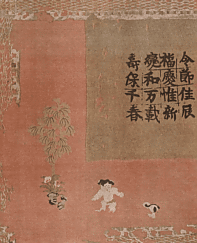 The oldest is in Sho-so
In Collection, Nara, Japan. In A.D.756, "2 Ren-sheng" were donated to To-dai-ji
with many treasures by an empress. Its list has survived in Sho-so In Collection.
The oldest is in Sho-so
In Collection, Nara, Japan. In A.D.756, "2 Ren-sheng" were donated to To-dai-ji
with many treasures by an empress. Its list has survived in Sho-so In Collection.
Scholars think this fragments of the "2 Ren-sheng". Figures and fortune words written fragment are silk. Surroundings are stencil of gold plucked papers. All are put up on silk. Fig. real size approx. 22cm wide, Entire size 33cm wide. On the style, scholars think it chinese.
Indeed gold foils cut for mirror backing were unearthed in B.C. tombs in Changsha, Hunan province, but I think it should be classified to goldsmith.
- Chi-Shu Yao, 1958, Beijing
- The Frederick M. Mayer Collection of Chinese Art, 1974, Christie
- Tokyo National Museum, MUSEUM, 1971, Tokyo